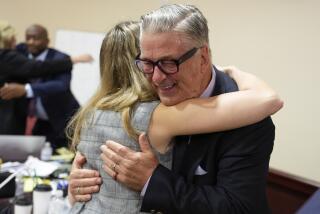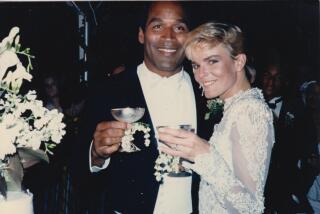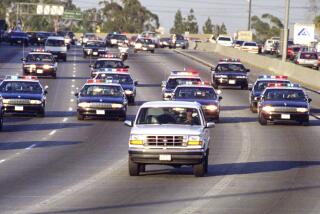Dramatic Evidence Caps DNA Case : Trial: Prosecutors present more test results. They show that blood consistent with Simpson and both victims was found in his Bronco.
Prosecutors in the murder trial of O.J. Simpson on Wednesday introduced dramatic evidence of blood drops found in Simpson’s Ford Bronco and on a glove outside his home--scientific test results disclosed during a court session in which government attorneys essentially completed the matrix of DNA evidence that they say links Simpson to the murders of his ex-wife and her friend.
Most significant of the newly introduced evidence was the testimony that blood consistent with that of Simpson and both victims was found inside the defendant’s Bronco--a potentially devastating development given that Ronald Lyle Goldman, the young waiter who was stabbed to death outside Nicole Brown Simpson’s condominium on June 12, had no reason ever to be in O.J. Simpson’s car, much less to bleed in it.
Although those conclusions were not the result of the most sensitive type of DNA testing, they were accompanied by dozens of other results: blood consistent with both victims and Simpson on a glove allegedly discovered outside his house; blood genetically matched to Nicole Simpson on a sock found in her ex-husband’s room; blood from the crime scene and from the grounds of his estate with markers consistent with Simpson’s blood.
Moreover, even as the government lawyers have presented the blood test results, they have laced their presentation with evidence intended to undercut the defense’s conspiracy theory. In an interview Wednesday, one prosecutor said the physical evidence alone proves that no such conspiracy could account for the results.
“It’s just impossible,” said Deputy Dist. Atty. Lisa Kahn, a member of the government team and an experienced DNA prosecutor. “If you look at all the scientific evidence, you realize that the defense theory just does not work.”
Kahn said the varying levels of DNA degradation, the splatter patterns on a pair of socks and the complicated mixes of samples all demonstrate that no conspiracy--even one involving many officers working together--could ever account for the physical evidence pointing to Simpson’s guilt.
Outside court, meanwhile, copies of the Los Angeles County coroner’s reports on the two murders reveal that analysts there tested four different types of knives to determine which might have caused the fatal wounds to Goldman and Nicole Simpson. Two of the four--a kitchen knife and a stiletto--produced wounds consistent with those of the victims, the report said.
Simpson has pleaded not guilty to the murders, and his lawyers have challenged the reliability of the DNA evidence, in part by suggesting that blood samples were tampered with, either intentionally or inadvertently. Simpson’s lead trial lawyer, Johnnie L. Cochran Jr., hinted at that argument as he left court, saying his response to the most recent evidence will be to show jurors that at least some of the blood samples are tainted with a preservative that he maintains provides evidence of tampering.
As the prosecution presented its results Wednesday, Kim Goldman, the sister of one of the victims, wept silently in the front row, tears rolling down her cheeks.
Just a few feet away, Simpson stared ahead or whispered to his lawyers as Gary Sims, an analyst from the state Department of Justice, ticked off one DNA test result after another. Simpson displayed no emotion and seemed not to pay close attention to the testimony.
A few DNA tests still are under way and the statistical significance of many of the DNA matches has not yet been calculated for the jury, but Wednesday’s presentation gave the 17 jurors and alternates all of the government’s existing DNA test results from the two major labs, Cellmark Diagnostics in Maryland and the California Department of Justice lab in Berkeley.
Using subdued tones to showcase striking results, Sims spent most of the day peeling off covers on a prosecution evidence board that detailed the results of DNA tests performed on stains from Simpson’s now-famous four-wheel-drive vehicle. Each time, the results were consistent with the prosecution contention that Simpson committed the murders, cut himself in the process, and tracked his own blood and that of the victims into his car and back to his Rockingham Avenue estate.
As with all DNA tests, Wednesday’s were accompanied by statistics signaling the significance of various “matches.” In some cases, they were staggering: One bloodstain on the inside of the glove could only have come from one in about 1.2 billion people, and yet the markers matched Goldman’s, Sims said.
Most of the statistics presented were less overwhelming, but nevertheless pointed to Simpson or the victims as the likely source of each stain. In some cases, the numbers told relatively little--one in 12 people, including Simpson, could have been the source of one stain on the inside of his car, while just one in 990 could have left one of the bloodstains on the vehicle’s carpet. That blood matched genetic markers in Nicole Simpson’s blood, the analyst said.
In response to such evidence, defense attorneys have dismissed the DNA test results as irrelevant, given their theory that the blood was planted by police.
Defense attorneys also objected to the statistical amplification that prosecutors proposed to apply to the evidence that was tested by both labs. Superior Court Judge Lance A. Ito said he plans to rule on that objection this morning, when Sims is expected to return to the witness stand for the third day.
Prosecutor Rebuts Conspiracy
With the defense arguing that police conspirators may be responsible for the DNA test results, Kahn said the physical evidence will debunk that theory even as it proves Simpson’s guilt.
The evidence shows that neither a lone officer such as LAPD Detective Mark Fuhrman nor a cadre of plotters could have accomplished such a frame-up, Kahn said.
Some DNA samples were degraded while others were easily typed, suggesting that they had been subjected to different degrees of exposure to the elements, Kahn said in an interview with The Times. That, she added, undercuts the planting theory because if the drops had been tampered with in the lab, they would have degraded at the same rate from that point on.
“If you just look at the science and what you have,” Kahn said, “the defense theory is impossible.”
Kahn added that the dual testing by two labs effectively precludes the defense from credibly arguing that any of the results are attributable to laboratory error.
“We have tested every relevant piece of evidence with every test that we had,” Kahn said. “We took all this evidence and subjected it to all those tests, trying to find anything that would exclude Mr. Simpson.”
Armed with the corroborating results from the two labs, Kahn added, “You can’t say human error. You can’t say they mixed up . . . samples at Cellmark because they got the same results at [the Department of Justice].”
Not only did the results fail to exclude Simpson as a suspect, Kahn said, they produced a staggering amount of DNA evidence pointing to his guilt. Although Kahn generally refrains from comparing DNA evidence to genetic fingerprinting, a commonly used but misapplied metaphor, the prosecutor said outside court that one set of tests in the Simpson case had effectively provided a “fingerprint” for one of the victims.
“We are confident in saying we’ve created a genetic fingerprint for Nicole Brown,” said Kahn, referring to the array of tests performed on the socks discovered in Simpson’s bedroom. A DNA expert last week said that only one in 6.8 billion people could be expected to have the set of genetic markers that her lab found in Nicole Simpson’s blood and in the socks. There are about 5.5 billion people on Earth.
Sims said his lab had subjected the same samples to tests using another set of markers.
Combined, those results suggest that neither lab made a mistake in testing that sample, and they emphasize the rarity of the blood that was found on the socks.
Experts agreed that the volume of DNA evidence in the case--and Kahn’s decision to submit the samples for testing at two different labs--combined to give the results uncommon punch.
“There has never been a case in United States jurisprudence where there has been such a wealth of DNA evidence tested in so many laboratories by so many methods,” said Eric Swenson, co-author of “DNA in the Courtroom,” a new book about forensic DNA testing. “Unless the jury buys the planting-of-evidence story, there is no way that this shouldn’t be conclusive.”
Simpson’s lawyers have said the blood on the socks was planted by police, but prosecutors have used the physical evidence to rebut that contention. The splatters on the socks showed more than two dozen blood drops, none of which soaked through from one side of a sock to the opposite--a staining pattern that suggests that they were being worn when the blood hit them, prosecutors say.
Moreover, the blood containing markers that match Nicole Simpson’s blood was found around the ankle areas, while a few stains resembling O.J. Simpson’s blood were found higher on the leg and on the toe of one sock. Those patterns, prosecutors maintain, suggest that Nicole Simpson’s blood was splashed on the socks at the crime scene, and that Simpson stained one sock when he returned home and pulled it off.
The location of stains on the bloody glove that Fuhrman said he found behind Simpson’s house also dovetails with the prosecution’s theory of the crimes--and could undercut the defense charge that the detective planted the evidence. Blood with genetic markers matching those of the two victims was found on 10 areas of the glove, but bloodstains containing markers that could have come from Simpson all were concentrated in one area: a notch at the base of the glove near the wrist.
Although Harmon was not allowed to ask Sims about that theory Wednesday, prosecutors allege that Simpson stained the glove with his own blood when he took it off, gripping it with his cut left hand.
Jurors See for Themselves
Some aspects of the prosecution presentation in the Simpson case have been difficult, but the past two weeks, with the focus on DNA evidence, have unfolded in dramatic, smoothly choreographed fashion. A pair of experienced DNA prosecutors with different styles--the tightly focused Harmon and the genial George Clarke--have presented testimony from an equally contrasting pair of witnesses, both of whom have confidently and carefully laid out the prosecution evidence.
First, Cellmark director Robin Cotton explained the science of DNA to the jury, and then she explained her lab’s test results. This week, Sims, a senior criminalist from the state Department of Justice, has told the panelists about his testing.
Harmon guided him through those results painstakingly Wednesday. At times, the questions seemed repetitive, but each emphasized the volume of DNA test results, and Sims assured the jury that he had no doubts about the credibility of his analysis.
Among the new results that jurors heard Wednesday were those of bloodstains taken from a set of three stains on the back gate to Nicole Simpson’s condominium. Defense attorneys have said those stains were among the ones that they believe police planted, an argument enhanced by the failure of the police to collect those samples on the day after the crimes.
Instead, those stains were not collected until July 3, weeks after the killings. Despite the delay, however, Sims said the blood produced results when subjected to DNA tests known as PCR analysis.
The results, he said, pointed to Simpson as the likely source. Only one person in at least 520 has the genetic markers of the blood found on that gate; those markers, Sims added, match Simpson’s.
“By these results, we would exclude Ronald Goldman,” Sims said. “We would exclude Nicole Brown.”
“And were you able to exclude the defendant?” the prosecutor added.
“No,” said Sims. “We were not.”
During the afternoon session, prosecutors wheeled a large light board back into the courtroom and let the jurors take a look for themselves at the latest DNA evidence. One by one, the panelists filed by the X-rays that display the various banding patterns produced by evidence samples and by the blood of Simpson and the two victims.
The jurors have spent two weeks learning the nuts-and-bolts of DNA analysis, so it was a knowledgeable group that studied the results Wednesday. As they did in a previous trip to the light boards, the jurors seemed to examine the X-rays carefully.
One man, a marketing representative from the Wilshire district, donned prescription sunglasses to ward off the glare from the boards and carefully studied each X-ray. Returning to his seat, he carefully recorded his observations in his notebook.
Two other jurors also appeared to pay unusual attention to the evidence displayed on the light boards. They jotted notes as well, and shared them with each other.
As even his own lawyers acknowledge, the DNA evidence against Simpson forms the strongest element of the prosecution case. But Simpson’s attorneys caution that observers should not prejudge their client, saying that they will present their own experts to question how the DNA tests are being interpreted and how contamination or tampering could have affected the analysis.
Some observers are skeptical, but others say the scientific evidence still may not carry the day.
“No matter how powerful the scientific evidence may be, there is still the human tendency to look for unequivocal evidence of guilt,” said Charles Ogletree, a Harvard University law professor. “And the fact that the jurors have not been given a weapon, an eyewitness, a confession or a clear motive still leads me to believe that jurors will be skeptical of the scientific evidence.”
Times staff writer Henry Weinstein contributed to this article.
More to Read
Sign up for Essential California
The most important California stories and recommendations in your inbox every morning.
You may occasionally receive promotional content from the Los Angeles Times.










